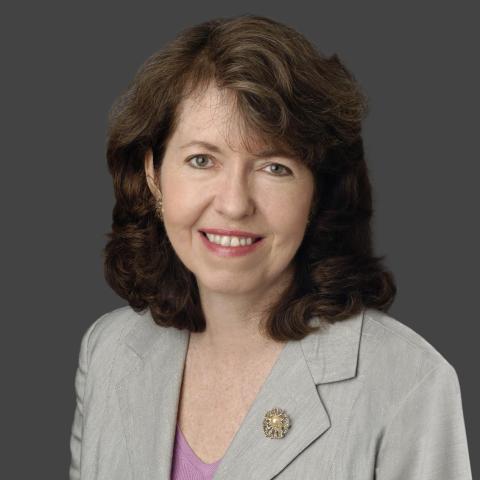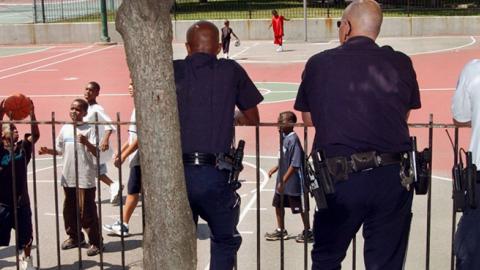Stoneham, Mass.
With violent crime on the upswing in the U.S., it sometimes seems that a sprinkle of magic dust could come in handy as police struggle to restore law and order.
But it’s another kind of magic—the magic of ordinary human connection—that Jay Paris likes to talk about in describing his work with black and Hispanic teenage boys and the mostly white officers who patrol the dangerous neighborhoods where they live. A training program he developed 12 years ago has helped reduce youth crime and made communities safer. It’s “magic,” he says, to watch kids and cops come together and “find all kinds of commonalities.”
Mr. Paris founded and leads the Youth and Police Initiative, a division of the North American Family Institute, a social-services agency headquartered north of Boston along the Route 128 technology corridor. YPI takes its cue from the strategy known as community policing, which encourages officers to get to know the neighborhoods they serve with the aim of stopping crimes before they happen.
“You can’t arrest your way to public safety,” Mr. Paris elaborates. “You have to build relationships in the community. One of the most critical points is with teens. If they have an experience that shifts their understanding of what’s across the ‘blue line,’ it can be transformational” for a neighborhood. YPI, he says, helps “kids and cops learn to talk at a more significant level, in a way that starts to build some trust and break down stereotypes.” Twenty-five cities, including Boston, Hartford, Conn., and Providence, R.I., have implemented YPI training in housing projects and other high-crime neighborhoods—with encouraging results.
The training is small-scale and targeted, focusing on one group of 12 to 15 teenagers at a time. Participants are mostly boys, and Mr. Paris estimates 98% are minorities—African-American, Caribbean-American, Hispanic. The teens are selected by local schools, youth organizations and, in some cases, parole departments or schools for juvenile delinquents.
One incentive to join is an $80 gift card each participant receives on completing the program. Another is food, no small attraction for teen boys. Dinner is served at every session. The money “helps get them in the door,” Mr. Paris says, but “in the end it’s not just the money, it’s the idea that they are helping” by sharing their point of view with local police.
The YPI training entails six after-school sessions. In the first four, each boy develops a personal narrative of his life to present to the eight to 12 police officers who will join them for the final two sessions. The kids are asked to speak about “choices they’ve made in four areas of their lives: peers, school, community and home,” Mr. Paris explains. “A boy might say, ‘At home, I stole some money from my mother. At home I’ve been in too many fights with my brother.’ . . . We have them practice at every session, standing up and sharing their choices in front of the group.”
The youths are nervous at first but soon get past the jitters. “I think they look forward to this opportunity. ‘They—the police—are going to hear me.’ . . . We all have a powerful need to be heard,” Mr. Paris says. “and teenagers don’t often have a chance to be heard by adults, to say nothing of the icons of authority in their community.”
When the cops show up in Session 5, they’re “amazed that these 15-, 16- or 17-year-old kids can actually stand up in front of police officers they’ve never met and share these intimate parts of their lives,” Mr. Paris says. “Then we ask the police officers to do the same. We give them a few minutes to draw a lifeline of how they got from being teenagers to making the decision to join the police.”
Like the youngsters, the officers “are generally nervous at first, as they aren’t used to sharing that kind of stuff—not even among their peers,” Mr. Paris continues. “But the inspiration from the kids really does push the whole process forward, and the officers always delve deeper into their experiences and start really sharing about their lives.”
As they get talking, the teens and the policemen move beyond suspicion to find points of connection. The boys discover, Mr. Paris says, that “a lot of officers came from difficult backgrounds that are similar to theirs.” The teenagers are astonished to learn that cops grew up with abusive fathers or alcoholic mothers, did drugs, or almost flunked out of school. “The kids are saying: ‘We thought you were the goody-good guys—that you were perfect,’ ” Mr. Paris says.
They also bond over another commonality. “If you’re drawn to being a police officer, you’re drawn to dealing with danger,” Mr. Paris says. “You like risk—and we know how teenagers feel about that. It’s endemic to being a teenager in virtually every culture that you’re attracted to risk.” Urban teens see the police as a kind of legitimate “gang”—with their own distinctive uniforms, colors, and weapons. “This is a very attractive and interesting thing to kids, even kids who come into the room thinking ‘I hate cops.’ ”
On the last day the boys and police develop a plan for future collaboration. “In Boston,” Mr. Paris says, “60 kids and 40 cops went to a Red Sox game and had a special tour.” Some cops give kids their cellphone numbers and encourage them to call. A YPI survey of 1,400 police officers who have completed the program found that 90% formed friendly relationships with at least five teenagers where they patrol.
These bonds between cops and kids are “sustained on the street,” Mr. Paris says. He can cite dozens of cases in which potentially dangerous situations have been defused because the officer on the scene recognizes youngsters from YPI and enlists their help. The cop takes the kids aside and asks what’s going on, and “they can talk and sort it out very quickly.”
Officers often become mentors to boys they meet at YPI training. “Police are very tuned into the resources of the community,” Mr. Paris says. They help the kids find jobs, direct them to social services agencies, and, perhaps most important, counsel them on personal problems. Many of the boys are growing up without fathers, and the policemen become powerful influences.
Mr. Paris says that when three groups of boys and officers in a single neighborhood—45 teenagers and 30 cops—have completed the program, it produces “a tipping point.” The neighborhood begins to change; violence drops: “Kids are getting jobs. Kids are getting rides. Kids are calling police officers. Kids are actually walking up to police officers in the street and chatting. Word gets out very quickly.”
YPI has received rave reviews from law-enforcement leaders, among them the Police Foundation’s Frank Straub. He brought in the training while running the police department of suburban White Plains, N.Y., and did so again when he went on to lead the police forces in Indianapolis and Spokane, Wash. “I believe in the power of the program,” Mr. Straub says. This kind of “intense work in the trenches” brings results. In White Plains in the late 2000s, Mr. Straub says, YPI helped reduce rates of serious crime to the lowest levels in 42 years.
In Boston’s high-crime Franklin Field housing development, 110 teens and 80 police officers completed YPI training between 2007 and 2010. Violent crime dropped 43.5% during that period, according to a survey by the city’s police department and housing authority. In nearby Chelsea, Mass., Mr. Paris has begun a Spanish-language program to improve ties between immigrant parents and police. He hopes to extend YPI’s reach through a train-the-trainer program, in which local police officers are taught how to conduct YPI sessions in their own cities.
There are also opportunities in counterterrorism work. Mr. Paris has applied the YPI model to a training program with Muslim teenagers in Boston. If you can build trusting relationships between police and Muslim communities, he says, “it’s a good way to flush out terrorists.”
The 68-year-old Mr. Paris had a long career as a photojournalist before moving into social services 17 years ago, when a friend asked him for advice on reforming a struggling school in Boston. An early influence dates to the summer of 1968, when as a rising sophomore at Princeton he received a grant to work at a school in the troubled Watts neighborhood of Los Angeles. During the 1965 riots there, clashes between African-American residents and mostly white police officers left 34 people dead. The summer three years later was the first time Mr. Paris remembers experiencing racial bias or living in a community where residents and police didn’t trust each other.
An FBI study released last month reinforces the importance of trust on both sides of the blue line. It found that law-enforcement officers in many places see “defiance and hostility” as “the new norm.” Some have become “scared and demoralized” and now “avoid interacting with the community.” The study also found that of 50 incidents in which cops were killed in the line of duty last year, 28% of the assailants had “expressed a desire to kill law enforcement officers prior to carrying out their attacks.”
Mr. Paris is undeterred. “As tough as things can get between police and communities of color,” he says, “I really think there’s a big opportunity to bridge that gap. . . . But you’ve got to bring it down to the humanity of both groups. If you have a way to do that so that communication builds, people can develop some empathy and mutual understanding. It can rip along at speed. That’s what motivates me to keep doing this.”















